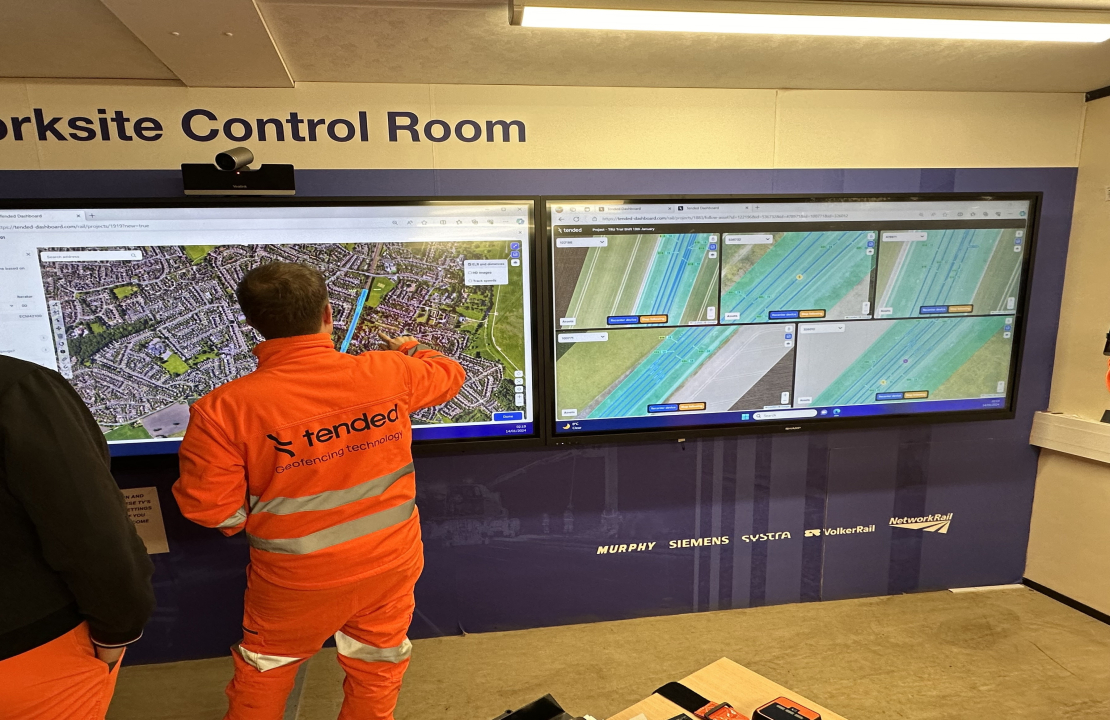CosmosIndex GmbH
Germany

August, 18 / 2025
With the close proximity of rail lines, complex worksites and human error, workers can lose situational awareness when placing protection equipment, stray onto live railway infrastructure or place the equipment in the wrong place or on the wrong line. This can lead to trains being stopped or colliding with the equipment, causing damage and lengthy network delays.
There are also high costs associated with infrastructure damage; for example, the costs associated with plant or machinery travelling through incorrectly set points is estimated at £250,000 per incident by the Rail Safety and Standards Board (RSSB).
Tended’s Digital Worksite moves beyond conventional and human-reliant practices, such as diagrams, paper-based plans, two-way communication and physical barriers, for managing worksites. The solution provides unrivalled worksite visibility to reduce the risk of human error and allow for the early identification of unsafe events to significantly enhance safety and efficiency.
Partnering with RTKFnet, the utilisation of Satellite Navigation systems like RTK (Real Time Kinematics) was integral to the success of the solution, enabling unprecedented real-time, centimetre-level accuracy of the position of people, vehicles and assets. Satellite Earth Observation Imagery has also supported the mapping of digital worksites where accurate maps are not usually available. This space-enabled ‘digital twin’ helps mitigate human errors and provides unprecedented oversight of live operations.

It enables organisations to create virtual boundaries - geofences - for designated safe zones on their worksites and specify the location of safety equipment, ensuring everything is in the correct place before work begins. The system automatically generates a live online map displaying real-time locations and movements of critical assets and equipment with alerts for risks such as vehicles approaching critical infrastructure or speed limits exceeded. This reduces the need for frequent two-way communication and enables early identification of unsafe events. Positioning devices worn by workers alert them the moment they exit safe work limits, notifying them to move back to safety and helping to prevent them from accessing open lines.
Prior to this project, Tended had a small presence in the rail sector, but working with ESA has proved to be game-changing in terms of progress and momentum, both for Tended and the rail industry. During their ESA pilot, Tended successfully demonstrated the system over 9,000 operational hours across live worksites, building confidence amongst procurement and safety teams. The pilot project exceeded KPIs and using the Net Promoter Score (NPS) metric, achieved a remarkable 63%, where the industry standard NPS is 36%.
Independent analysis suggests the adoption of the Digital Worksite not only dramatically improves worker safety but could also deliver up to £60 million per year in efficiency savings across the UK rail network.
"We are pleased to have supported the Digital Worksite project, which is improving the safety and efficiency of rail maintenance and infrastructure” said Enrico Spinelli, Applications Engineer at ESA. “This project has potential for wide-scale adoption across the industry, saving lives and increasing efficiency and is already enjoying remarkable commercial success.”
Dr Craig Brown, Investment Director at the UK Space Agency, said: “Space data and services provide a huge opportunity to improve safety and operational efficiency across many different sectors, and this is a clear demonstration of using space in an innovative way to deliver those benefits. The Digital Worksite showcases how satellite positioning and imagery can transform rail maintenance into a safer, smarter, and more responsive environment. By turning worksites into intelligent ecosystems, this project not only addresses long-standing safety challenges but also sets a new benchmark for operational excellence across infrastructure and transport.”
Leo Scott Smith, CEO and Founder at Tended said: "The ESA BASS programme has been invaluable, offering significant benefits to both our company and the broader rail industry across the UK and Europe. ESA's support in developing this safety innovation, through access to crucial space-based assets, has been instrumental in achieving the high accuracy and realistic representation of live rail environments. ESA has been pivotal in our journey in ensuring people stay safe on the rail network, providing expertise and resources that have accelerated the development and deployment of this important safety innovation."
The success of the Digital Worksite has set the foundation for industry-wide transformation and the system generated £1.28 million in annual revenue during project pilots. A four-year contract has been agreed for the Network Rail Wales route with additional contracts secured with Siemens Mobility, SPL Powerlines and others across Europe. This commercial success heralds a new era of rail safety for those working in safety-critical rail environments across Europe.

The two organisations are working together to facilitate the development of innovative, space-enabled solutions for the sustainability challenge in three critical areas:
As a first step in this collaboration, Love Tomorrow is supporting the new BASS funding opportunity, ‘Space for Sustainability in Sports and Mass Events’ which is open until October this year. Love Tomorrow is involved in this funding call as a prospective customer and has identified a number of critical domains for their operations that they intend to support. Data shows that transportation accounts for 73% of Tomorrowland’s carbon footprint, so the aim is to support innovative ideas that will use space-based technologies to develop smarter, greener mobility to reduce environmental impact and improve visitor travel experiences at large events.
“This is an important collaboration between two organisations with common goals” said Davide Coppola, Head of Space Applications Initiatives Section at ESA. “As festival season gets underway in Europe, we are working together with industry to use space technology to reduce congestion, minimise air pollution and develop safe and accessible solutions for end-to-end journeys.”
As well as looking at mobility solutions, ESA and Love Tomorrow are also addressing challenges around transparency in the whole events supply chain, from refreshments to stage materials. The goal is to support projects which leverage space data to ensure responsible sourcing, ethical food systems and more efficient use of resources.
France